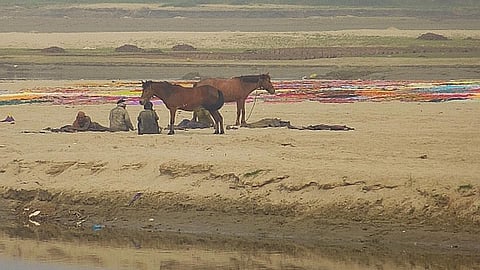
- Topics
- Feature
- Opportunities & Events
- Data
- Hindi Portal
- Topics
- Feature
- Opportunities & Events
- Data
- Hindi Portal

We sat on a charpoy in Agwaanpur and talked of flood warning systems for the Ramganga. Of all the places I had visited, Agwaanpur, probably due to its urban nature, was the only one which boasted a rudimentary system. The police would inform the Maulvi that a flood release was expected, and he would repeat the warning using the loudspeaker normally used to summon people to prayer.
Mohammed Rahiz seemed unimpressed. "What's the point of a warning"?, asked the handsome grey-bearded farmer. And his next sentence convinced me that he was right. "Theek hain, If we are within earshot, we get up from our work on the farms and come here. What about our fields? They can't get up and run away, can they"? And then he went on to explain why these floods were so very devastating.
This is due to a change in what are known as 'environmental flows'. Environmental flows are the varying levels of water in a river that are needed to maintain the river ecosystem. This means year-round deep water pools for dolphins, shallows during the time fish spawn, and floods to inundate wetlands and floodplains and to bless the farmers.
The farmers are well-used to floods during the four months of monsoon. The Chaumasa, as it's called, is when farmers allow themselves the luxury of slowing down. This is their time to take stock, plan and gear up for the all-important Rabi or winter crop. The farmers that live the Gangetic basin do not approach any river at this time. As soon as the floods recede, exposing their fields covered by a coating of fresh silt, they begin to till their land. It is here that the Ramganga deals with them unfairly. Frequently, floods occur after the seed has been sown, wiping out their investment.
But let's not blame the Ramganga.
The fault lies with the dams and barrages constructed upstream of it. Simply put, there are three major changes that the dams do to the flow regime:
This is made even worse because there is nothing that the farmers can do to counteract the god-like powers of the dam authorities.
Consider Razia, a landless farmers in Agwaanpur who is doing the best she can to make the most of her limited resources. With a blind father-in-law and a deceased husband, Razia is the head of her household. Every year, she pays Rs.10,000 to lease a bigha of land. Earlier, she would do Paalej farming- the planting of cucurbits. When unpredictable fluctuations in both river flows and market prices made this too much of a gamble, Razia changed her strategy. She saw that planting eucalyptus and poplar for sale was the new big craze in the area.
However, she cannot afford to wait for 5-10 years before securing a return on her investment. Instead, she went to the Forest Department and obtained eucalyptus seeds for free. She has now planted a nursery, and will sell 1 year-old saplings to the farmers.
A seemingly smart plan with a sure income, low investment, quick returns, and a ready market but one that isn't certain by any means. No matter how hard she works and how intelligently she plans, Razia cannot predict when the floods will come and if they will wash away her carefully tended seedlings.
The impacts of a river development scheme on the farmers of the same river basin seem to be secondary to those of far-off command areas as far as planners are concerned. The Ramganga is said to fulfil its objectives since it supplies adequate water to the Upper Ganga Canal command system. The devastation to the farmers who have traditionally lived along its banks is 'the price of progress.'
Climate change is playing a role here too. Er. Ravindra Kumar, retired official of the UP Irrigation Department confirms that since 2010, increasingly erratic rainfall has led to unplanned releases. Regrettably, this has not inspired the UP Irrigation Department o reassess the value of the dam or look for alternate means of functioning. Instead, Er.Kumar says that the adopted strategy to deal with a future of more intense rainfall is the building of embankments at vulnerable places. Unfortunately, we have seen time and again that embankments only worsen flood situations but our state irrigation departments seem to have missed reading those same reports.
There is some help on the way. The World Wildlife Fund for India has begun an ambitious plan of demonstrating on the Ramganga that environmental flow releases are possible on a dammed river. This entails working on several strategies at once.
This does raise an important question, however.
How will this effort change the perception of agricultural water demand? In other words, how will assessing the environmental flow requirements of the Ramganga convince the dam authorities that less water needs to be abstracted from the river for the canal system?
That depends on WWF's capacity for negotiation.
Mohammed Rahiz, Razia Begum and countless other farmers are likely waiting for the results of this with bated breath.